Reaping the Rewards: Can You Escape ‘The Night Cage’?

Trapped in the darkness in an ever-changing maze, you and the other lost souls must find your way out before the light runs out. But beware! You aren’t the only ones creeping around in The Night Cage.
In “Reaping the Rewards,” I take a look at the finished product from a crowdfunding campaign. The Night Cage was originally funded through Kickstarter in the fall of 2020, and was shipped to backers in the fall of 2021, and is available now.
What Is The Night Cage?
The Night Cage is a cooperative tile-laying game for 1 to 5 players, ages 14 and up, and takes about 50 minutes to play. It retails for $44.99, and is available in stores and directly from the publisher. The gameplay is not too complex (particularly before you throw in a lot of the extras), so you could play with younger kids, as long as they’re not creeped out by the theme. It does have a horror theme, with some evocative imagery, but nothing gory or too graphic—a lot of it is up to your imagination.
The Night Cage was designed by Chris Chan, Chris McMahon, and Rosswell Saunders and published by Smirk & Laughter Games (an imprint of Smirk & Dagger), with illustrations by Chris Chan. (It may seem a bit strange that this one is in the Smirk & Laughter line because it’s not a cheerful game, but that’s the imprint they use for their games that don’t have as much back-stabbing, and The Night Cage is fully cooperative.)
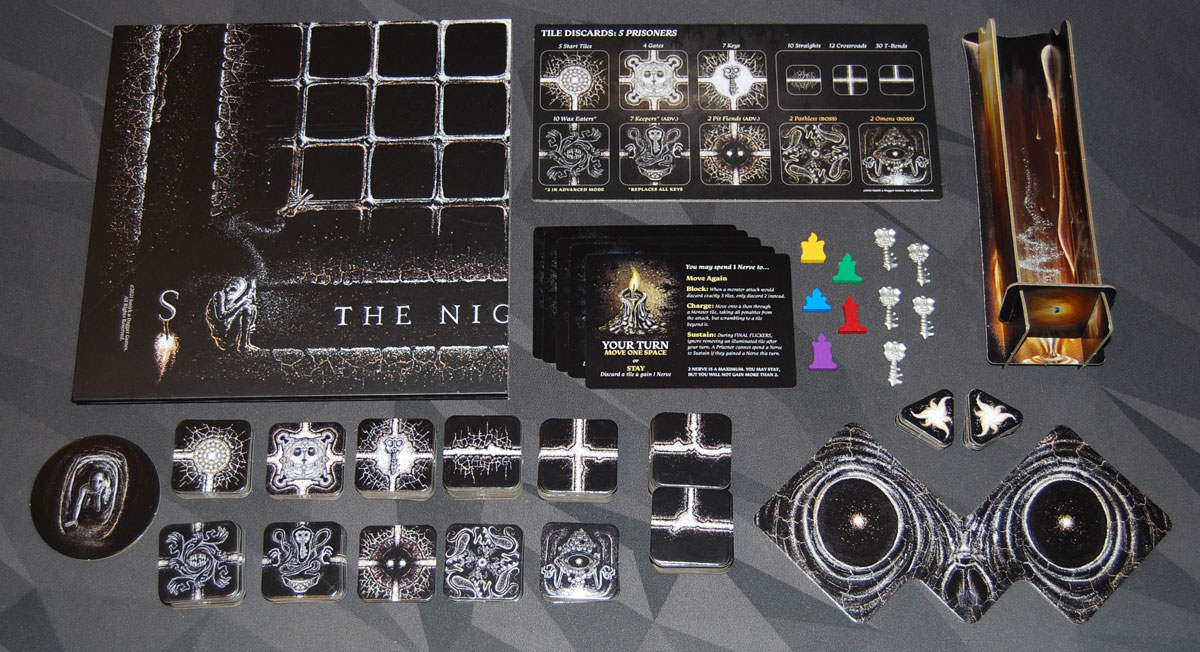
The Night Cage Components
Here’s what comes in the box:
- Game board
- Discard board
- 100 Labyrinth tiles:
- 5 Start tiles
- 8 Key tiles
- 4 Gate tiles
- 13 Wax Eater Monster tiles
- 10 Straight Passage tiles
- 32 T Passage tiles
- 12 4-Way Passage tiles
- 14 Nerve tokens
- 4th Prisoner marker
- 5 Prisoner meeples
- 5 Prisoner Status cards
- Tile holder
- 5 Key tokens
- Advanced Monster Tiles:
- 8 Keepers
- 3 Pit Fiends
- 5 Omens
- 3 Pathless
- 1 Dirge

The tile holder is made to look like a candle with three sides, and the fourth side is open so you can access the tiles. As tiles are removed, it reveals the illustration of a spent candle behind the stack of tiles.
The labyrinth tiles and monster tiles are square, with the same back showing a pit with four passages leading out of it. (The exception is the Dirge tile, which is a massive shape that covers 9 squares on the board.) The illustrations are in black and white and really help create the atmosphere of being lost in a dim maze—there’s actually very little color overall in the entire game: the meeples are colored and there’s some coloring on the player status cards, and the tile holder itself has the yellow wax, but aside from that everything else is mostly black and white. The monsters are creepy half-seen figures with lots of teeth and arms and tentacles; the Pit Fiend is just a pair of glowing eyes staring out from a black hole.
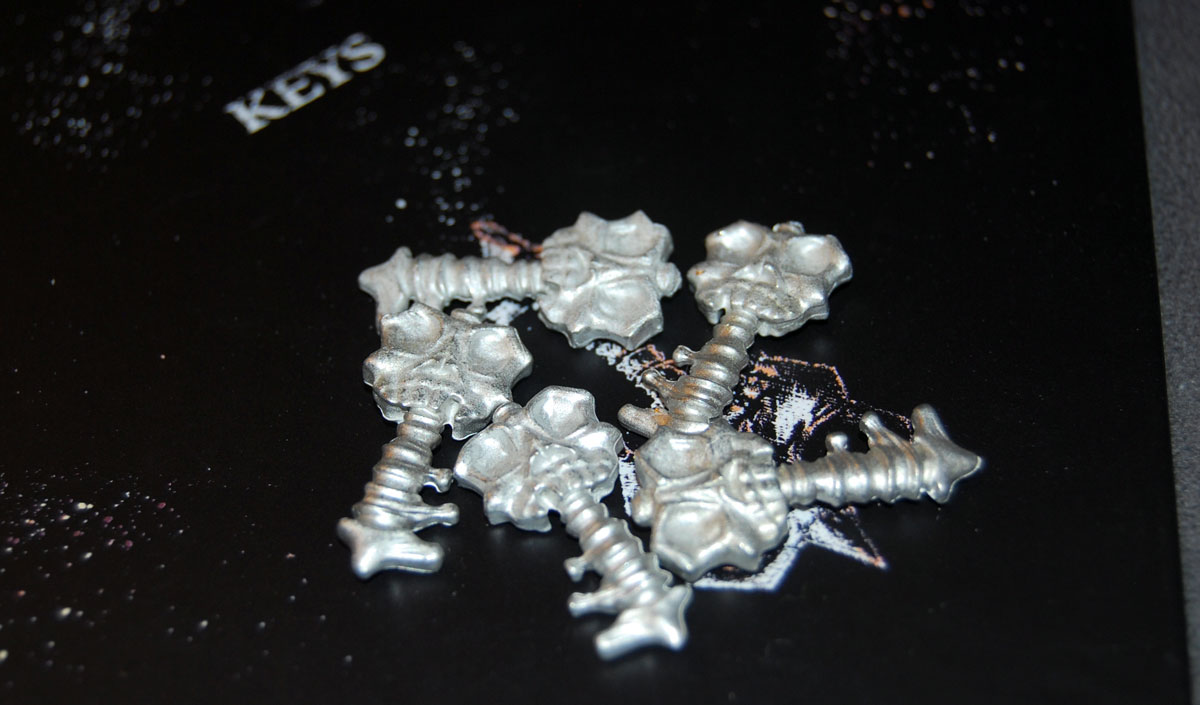
The keys are made of metal, and look like little skulls and bones. The prisoner meeples are candles, and each actually has a slightly different shape, which would seem nice for color blind players, except that the player status cards all use the same candle illustration (just in different colors) so I guess you’d just have to remember which height your candle is.

The game board and the discard board are both double-sided, with one side used only for the 5-player game. The discard board shows you the number of each tile type included in the game, so you can keep track of what has been revealed.
The box is just a basic square box, with no insert, so you’ll need to find your own way of organizing things. I store the non-advanced tiles in a stack in the tile holder, which works well enough as long as nobody turns the box around too much or they could spill everywhere.
How to Play The Night Cage
You can download a copy of the rulebook here.
The Goal
The goal of the game is to escape the maze: each prisoner must find a key, and then the group needs to assemble at a gate before the darkness closes in.
Setup
Note that there are always at least 4 prisoners in play, so if you have fewer than 4 players, you still set up for 4 prisoners—divide up the prisoners evenly among the players. For a 3-player game, control of the 4th prisoner will be shared, passing the 4th Prisoner marker clockwise each time that prisoner is used. Each prisoner has a prisoner status card (set to the lit candle side), a prisoner meeple, one nerve token, and a starting tile.
Create the tile stack by mixing together a particular combination of labyrinth tiles based on the number of players, with a certain number of passage tiles mixed together at the top of the stack. The key tokens and nerve tokens are placed on the main game board in the indicated spaces, and the discard board is set nearby.

In turn order, each player places their starting tile on any unoccupied space on the board and places their meeple on it. Then, they draw tiles from the stack, connecting them to the two exits on the tile. (If any of your exits touch other tiles, then you don’t draw the additional tile for it.)
Gameplay
Your candle is dim, and can only light tiles that are directly adjacent to your current location. So anytime you move, you must draw tiles to fill in spaces around you that would be illuminated by your candle, and remove any tiles from the board that are no longer illuminated by any players. Also, the board wraps around, so if you move off the left side of the board, you connect to the right side, and the top is connected to the bottom. This applies to illuminating spaces as well.
On your turn, you must choose to move or stay.
To move, move 1 space along any passage to a connected tile. Remove any tiles that are no longer illuminated, and draw tiles to place in any newly illuminated spaces. If you move from a crumbling tile (with cracks shown around it), it is flipped over and becomes a pit after you leave.
If you land on a key tile, you may pick up a key token—however, you can only carry one key token. You may pass a key to an adjacent player as a free action.
Gate tiles are the only tile that may be occupied by multiple players at a time.
To stay, you gain a nerve token, and discard 1 tile from the draw stack to the discard board (because even if you stay put, your candle is still using up wax). Note that if the tile drawn is a monster, you must place it in a location connected to you and discard any existing tile there instead. If the tile you were on is a crumbling tile, then it turns into a pit (flip the tile over) and you fall.

Unfortunately for you, falling does not get you out of the night cage, this infinite loop of misery. After you fall, you place your meeple along the board edge marking either the row or column where you fell. On your next turn, choose any empty space along that row or column, draw a tile to land on, and place it and your meeple there.
If you land on a monster tile, it immediately attacks before you even illuminate the spaces around you, and then after resolving the attack you move to an adjacent space (placing a new tile if needed). If there are no tiles left in the draw stack to land on, you fall forever and everyone loses.
The monsters have various effects. In the basic game, the only monsters you face are the Wax Eaters. Wax Eaters respond to motion and will attack any time a prisoner moves into or out of their line of sight, all four orthogonal directions along passages. (Empty spaces with no tiles block line of sight.) If you move in a Wax Eater’s line of sight, then the Wax Eater attacks in all four directions—though you could move out of its line of sight, triggering an attack but not getting hit. If a Wax Eater hits another Wax Eater, the second monster also activates (but does not hit the first monster back).

If you are hit by a Wax Eater, you must either discard the top 3 tiles from the draw stack, or go “lights out”: flip your status card over to the extinguished candle side. Your candle is no longer lit, so it does not illuminate spaces next to you and those tiles are removed (unless lit by other players). You are now panicking, so you must move every turn and are not allowed to stay unless you spend a Nerve token. When you move, you draw a tile, place it, and move onto it. If you are hit by a monster when you are already lights out, you must take the “discard 3 tiles” penalty, and also draw a new tile to move to.
You may have up to 2 nerve, which can be spent for one of the following effects:
- Spend 1 nerve to move again on your turn.
- Spend 1 nerve to stay when you are lights out. (You do not earn the nerve for staying.)
- When hit by a monster attack, spend 1 nerve to discard 2 tiles instead of 3.
- Charge: spend 1 nerve to move onto a Monster tile—you immediately go lights out and suffer its attack, and then move onto an adjacent space.
- Sustain: during Final Flickers (see below), skip removing a tile at the end of your turn.
Game End
The game will enter the Final Flickers phase when the draw stack is empty. Your candles are running out! From now on, at the end of your turn, you must remove one additional tile from the board and discard it.
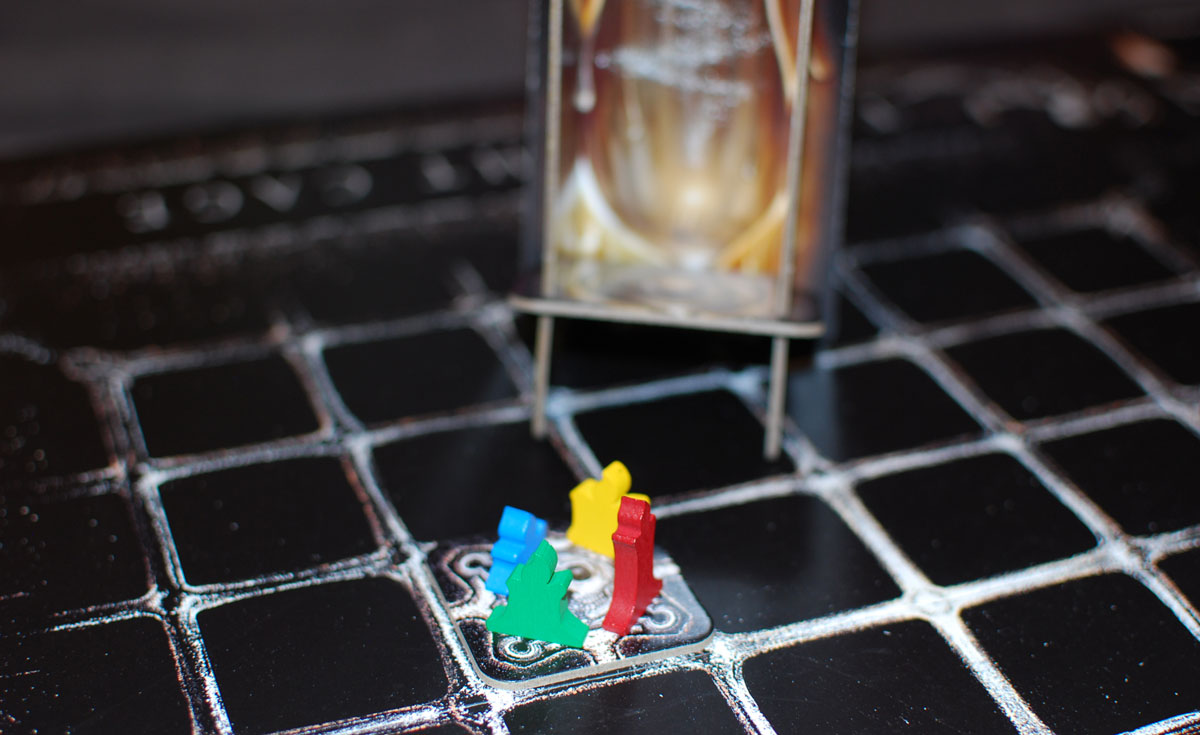
If all prisoners have a key and they all convene on the same gate tile, they escape and win!
If you cannot reach the gate before the darkness isolates you, you all lose the game. (You also lose if all 4 gate tiles are discarded, or enough key tiles have been discarded that not every prisoner can get a key.)
Advanced Game
In the advanced game, you meet two new types of monsters: Keepers and Pit Fiends. The key tiles and some of the Wax Eaters are removed and replaced with these new monsters.
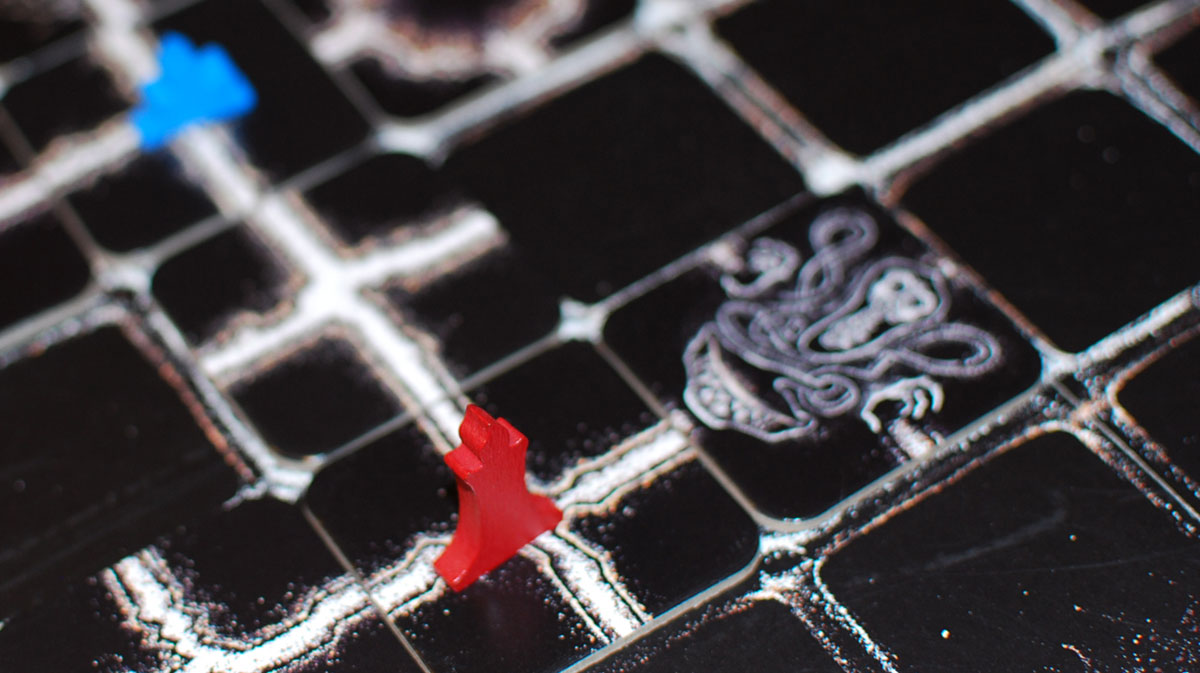
A Keeper is similar to a Wax Eater but is only triggered from three directions, and attacks those directions. The fourth direction, its back, holds a key. To get a key, you must move onto the Keeper from behind.
When a Pit Fiend is placed on the board, it immediately turns all tiles in straight diagonal lines into pits, flipping them over. (Pit Fiend attacks do not wrap around the board edges.) This may cause prisoners to fall, which may remove tiles that are no longer illuminated. The Pit Fiend then flips over and is a pit as well.
There are also two boss monsters that can be included for an additional challenge.
The Pathless behaves like a Wax Eater, but it can attack through empty spaces on the board and through walls, and require you to discard 5 tiles.
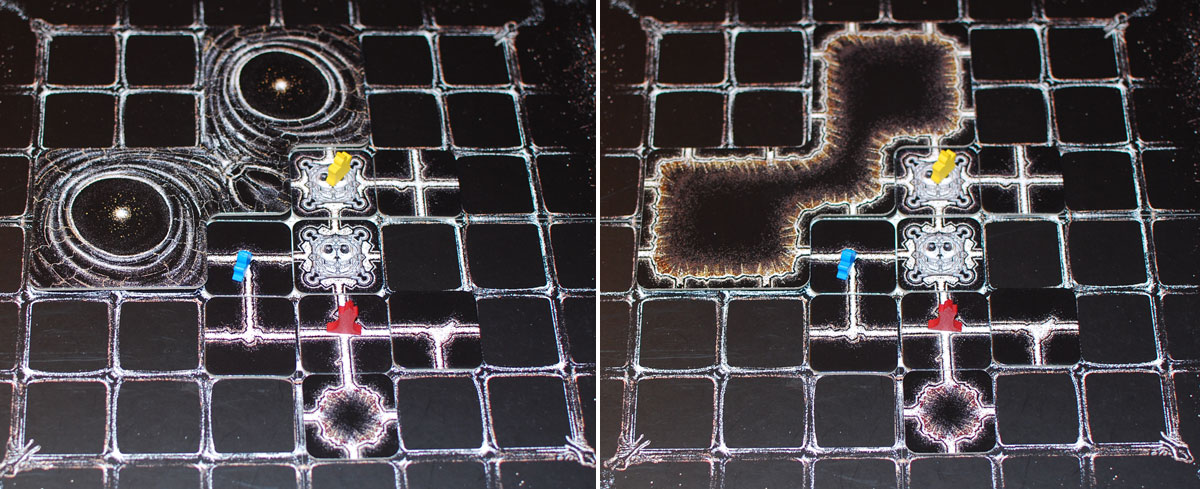
The Dirge isn’t mixed into the stack (because it’s too big!) but is summoned when the two Omens have been drawn. The first Omen is not placed on the board but is just discarded when drawn and replaced with another tile. When the second Omen has been drawn, it is placed on the board like a normal tile, and then the Dirge is placed so it overlaps the space where the Omen is. Everything under the Dirge tile is removed, any prisoners on those spaces go lights out and discard 3 tiles and fall into a pit. Then the Dirge tile is flipped over, becoming a massive pit space that remains until it is no longer illuminated by any players.
Why You Should Play The Night Cage
I got to try The Night Cage on Tabletop Simulator a few times during the Kickstarter campaign but didn’t have time for a full review at the time. Smirk & Laughter provided a finished copy for me to try out, and so I’ve gotten to try it some more, this time with other players in the same room, even!
The Night Cage is a spooky puzzle that lives up to its name: it can be very hard to escape, and you do get the feeling of stumbling around in the dark, hoping you don’t run into something toothy around the next bend. There’s a bit of luck involved just in the order that the tiles are drawn—if all of your gate tiles appear early on, then you really don’t stand a chance of finding all the keys while at least one prisoner camps out to keep the last gate from disappearing.
Much of the time you’ll be crawling along during your turn, looking for a key. But once you’ve found one, you generally don’t want to find another one, because you can’t pick it up. The very short reach of your candle means that if there’s a tile you want to keep around, your choices are to move onto it or stay put—if you walk in any other direction, that tile is lost to the darkness (assuming nobody else is around to keep it illuminated). But key tiles crumble—if you step on it, it’ll go away on your next turn. However, when you stay put, you discard tiles from the stack, and sometimes that means you discard a key or a gate, which could cost you the game. Worse yet, you might discard a monster … and then you’re stuck placing it next to you.
The Wax Eaters, the monsters used in the standard game, aren’t terrible one at a time. Unless you’re in a straight passage, you can just step to the side and the monster will miss you. (And if you are in a straight passage, you could take the risk of just staying put, which means you fall into the pit and the monster misses you that way as well—just watch where you land!) Where it gets tricky, though, is when you have multiple monsters in line with each other, and multiple players exposed to them.

The photo above shows a situation that cost us dearly. The red player had been hoping to stay put to hold the gate tile, or at least stay next to it to keep it lit, but three tiles adjacent to the gate turned up as Wax Eaters. Meanwhile, the green player ran into a fourth Wax Eater—and now we have a situation. Remember, the board wraps around the edges, so the Wax Eaters on the right side of the board are directly adjacent to the monster and the gate on the left side. If either red or green moves (or if yellow decides to move up for some reason), then all four Wax Eaters will trigger. If red moves, green gets hit twice. If green moves, red gets hit three times! That would mean discarding nine tiles from the stack—a good way to lose keys and gates, and probably enter the Final Flickers.
Of course, even that may not be challenging enough for some players, which is where the advanced tiles come in. The Keepers are tricky because when you draw one, you always have to place it facing you—so now somebody else has to manage to get behind it without ever triggering it on one of the sides. If they’re not already in place, you just have to hold still, discarding tiles for every turn that you stay. If you have some nerve, you can spend it to charge at the Keeper yourself to get the key, but then you end up in lights out, and it still costs you more tiles on top of that. Managing to collect all four keys from the Keepers is quite difficult.
And then there’s the Dirge, which is just absurdly large. Trying to fit the tile in a way that doesn’t make all the players go lights out can be hard, and then trying to move everyone away from the pit so you can remove it is another tricky task. While the pit is on the board, it also means you have a lot less space to maneuver when other monsters show up.
The Night Cage is fully cooperative and everybody has the same information, so it’s the sort of game where it can be easy for everyone to be giving advice and making suggestions throughout the game. That can feel reinforced by the fact that you always have 4 (or 5) prisoners on the board regardless of player count. Depending on your group’s style, that can be fun because it’s truly collaborative, or it can feel like too many people quarterbacking a game of solitaire. There aren’t any rules about limiting communication, but I suppose you could make a house rule that players can’t talk during somebody else’s turn unless their characters are near each other, because those Wax Eaters respond to noise as well as movement.
If you enjoy tile-laying games and mazes, and you don’t mind sometimes losing to bad luck and sometimes losing to bad decisions, The Night Cage is a delightfully doom-filled game, perfect for a spooky game night.
For more information about The Night Cage, visit the Smirk & Laughter website.
Click here to see all our tabletop game reviews.
![]() To subscribe to GeekDad’s tabletop gaming coverage, please copy this link and add it to your RSS reader.
To subscribe to GeekDad’s tabletop gaming coverage, please copy this link and add it to your RSS reader.
Disclosure: GeekDad received a copy of this game for review purposes.
Click through to read all of "Reaping the Rewards: Can You Escape ‘The Night Cage’?" at GeekDad.If you value content from GeekDad, please support us via Patreon or use this link to shop at Amazon. Thanks!

